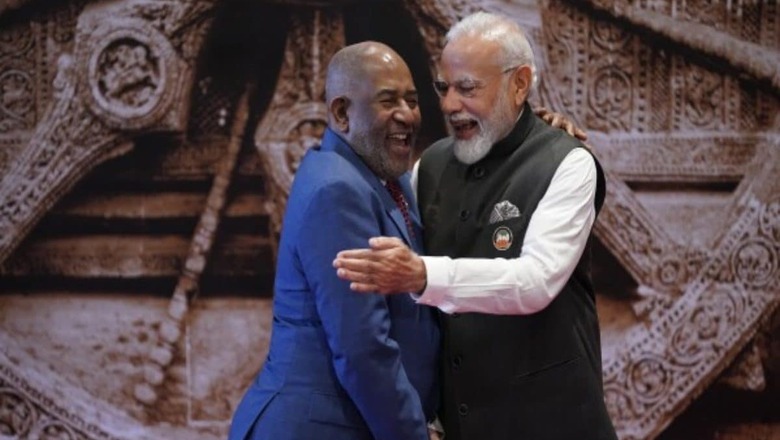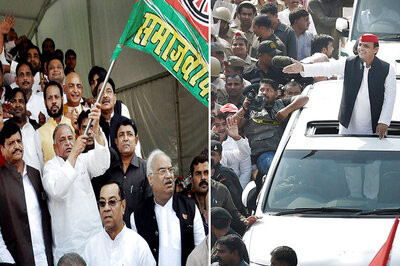
views
A big theme of 2023 was India’s emergence as ‘Vishwa Mitra’, hosting the G20 conclave and facilitating the entry of the African Union into the body. 2023 witnessed India’s emergence as a champion of the Global South, and a nation which regularly voices the developing world’s concerns.
In diplomacy, one must, as a prerequisite, take a long-term view of things. Building inter-continental partnerships that stand the test of time often takes time and money. It is crucial, therefore, for countries to have a great appetite for patience when looking to expand their influence beyond their own borders. India recognises the importance of forging international partnerships with like-minded nations and even entire continents. It is viewed as a player that does not have expansionist proclivities at the centre of its diplomacy.
India is not offering mere lip service. It is backing its talk of aiding the Global South by making significant investments in Africa and Asia. Lines of credit offered by India are having an especially transformative impact on how India is viewed by the collective Global South.
The External Affairs Ministry has informed that India has so far offered 308 lines of credit (LOC), worth about $32.02 billion, to various partners in Asia and Africa. MoS V. Muraleedharan says that these funds have supported more than 600 development projects in sectors such as infrastructure, power, connectivity and health across countries of the Global South. About $17.06 billion has gone to countries in Asia, $12.15 billion to those in Africa and $2.81 billion to countries elsewhere. In Asia, New Delhi’s “Neighbourhood First” policy remains at play, as is evident from the grant assistance projects with countries such as Afghanistan, Bangladesh, Maldives, Myanmar, Nepal, Sri Lanka and Bhutan.
These include the construction of the India-Bangladesh Friendship Pipeline (IBFP), the India-Nepal cross-border Jaynagar-Bardibas rail link, restoration of the Thiruketheeswaram temple in Sri Lanka’s Mannar, the Afghan-India Friendship Dam, power substations at Doshi and Charikar in Afghanistan, among others.
The case of Sri Lanka stands out in particular. India rushed to the crisis-hit island nation’s rescue when much of the world, including China, remained non-committal to help it. For example, at the height of the financial and economic crisis in Sri Lanka, India swiftly extended a lifeline to the country with assistance of over $4 billion, surpassing even the International Monetary Fund’s 48-month bailout of about $3 billion.
Military-to-military ties between the two sides also witnessed a fillip, as many Indian naval ships, including the INS Batti Malv, INS Nireekshak, and INS Delhi docked at Sri Lankan ports throughout 2023. In a big win for India, Colombo has also placed a one-year moratorium on allowing foreign vessels to conduct research in its territorial waters – a move aimed at keeping Chinese surveillance ships out of the region.
Importantly, between 2014 and 2020, India’s LOC to its neighbours had increased fourfold, going from $3.27 billion to $14.7 billion. The largest concessional credit given by India to a country has been to Bangladesh, worth about $8 billion.
India: A Force of Good in Africa
Apart from its immediate neighbours in the Indian subcontinent, perhaps no continent is as important to New Delhi’s growing diplomatic and economic heft like Africa. The highlight of India’s G20 presidency will always remain the inclusion of the African Union into the powerful group. Importantly, it was India that did all the diplomatic heavy-lifting to ensure that the African Union be granted membership to G20 in a timeframe that, for the lack of a better word, can be called tight.
Africa now figures most prominently in India’s outreach to the Global South. While trade ties between the African Union and India are definitely witnessing an upswing, it is India’s developmental push in the continent that is making a lot of difference. India is being viewed as a country that does not seek to burden nations with debt, but actually wishes to be a partner in their upliftment.
Also Read: India’s Gati Shakti Masterplan to Go Global, Pioneering New Era in International Infrastructure Development
The relationship between India and Africa has always been special. Sample this: since the 1960s, India’s prime ministers have visited Africa 76 times. No other country in the world, and neither any of Africa’s other big partners can boast of such a shining record in high-level engagements. Between 2015 and 2022 alone, India hosted over 100 African leaders.
Today, India is Africa’s third largest trading partner after the European Union and China. Trade between both the sides has risen 18 per cent since 2003, and has reached $103 billion this year. Indian products now represent 6.3 per cent of Africa’s total imports. India is also the second largest lender in Africa. 42 African nations received about $12 billion or 38 per cent of all credit extended by India in the last 10 years. Meanwhile, total Indian investments in Africa stand at about $70 billion, with the goal being to take the figure past the $150 billion mark by 2030.
India has emerged as a pioneer in the world of digital public infrastructure. Therefore, it is no surprise that today, Africa’s largest digital project, the Pan African e-Network, is connecting 54 African countries to India in order for them to gain expertise in telecommunications, medicine, health, resource mapping and digital governance. Meanwhile, in an important move that will accelerate financial inclusion across Africa, the Indian government this year decided to contribute $2 million to the Africa Digital Financial Inclusion Facility (ADFI), managed by the African Development Bank.
The primary tool for India to invest internationally is the Exim Bank, which is a wholly-owned subsidiary of the Indian government. The Exim Bank has devoted a staggering 50 per cent of its international financing, technical assistance, and trade promotion schemes to Africa.
Importantly also, over the past nine years, India opened 25 new embassies and consulates across the world, and 18 of these were in Africa alone. That makes India’s diplomatic expansion in the African continent quite visible. It represents a resolve on New Delhi’s part to become a major player in Africa, while also challenging powers that have only their vested interests at heart and are looking to exploit the continent’s resources.
2023 was a year in which India doubled down on its efforts to become a trusted military and defence partner of Africa. In March, India hosted the India-Africa Army Chiefs’ Conclave and the Africa-India Field Training Exercise, during which potential defence equipment, products and services deals remained a key talking point. Defence Minister Rajnath Singh confidently told African representatives that “the Indian defence industry can work with you to fulfil your defence requirements.” And over the past four months, the Indian Navy’s INS Sumedha has been travelling along the African coast and taking part in maritime exercises. The deployment has helped enhance interoperability with African navies in the Indian Ocean Region.
On the renewable energy front, India’s role has assumed significance globally. By founding the International Solar Alliance, of which 44 African nations are a part, India’s National Thermal Power Corporation has been able to secure contracts to develop solar parks in Mali and Togo. Additionally, India is also looking to invest in Sudan, Mozambique, Gambia, Malawi, and other African countries. Also, in 2021, the Indian government pledged $2 billion in concessional credit for solar energy projects in Africa.
India is driven by a desire to aid Africa in its development journey. A stronger Africa will, in turn, help India ensure freedom of movement in the Indian Ocean Region and counter the nefarious designs of certain hostile powers, who in Africa have earned a reputation for engaging in blatant “debt-trapping”. Having a robust relationship with African nations will also play a crucial role in India getting a permanent seat at the United Nations Security Council. Africa, being resource-rich as it is, can also help India’s energy interests.
Together, India and Africa can be a force for global good and set an example on how relationships built on mutual respect can be a catalysing factor in an entire continent’s development.
Views expressed in the above piece are personal and solely that of the author. They do not necessarily reflect News18’s views.



















Comments
0 comment